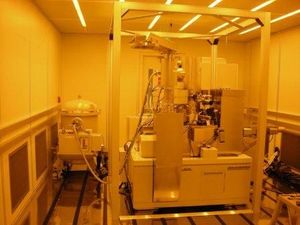Difference between revisions of "E-Beam Lithography System (JEOL JBX-6300FS)"
Jump to navigation
Jump to search
| Line 36: | Line 36: | ||
*Stage control to 0.6 nm accuracy (λ/1024) |
*Stage control to 0.6 nm accuracy (λ/1024) |
||
*Two deflector/objective lens system: |
*Two deflector/objective lens system: |
||
| − | *5th Lens (8nm) and 4th Lens modes (25-40nm) |
+ | **5th Lens (8nm) and 4th Lens modes (25-40nm) |
*Dynamic Focus and Stigmation Control |
*Dynamic Focus and Stigmation Control |
||
*10 mm/sec maximum stage speed |
*10 mm/sec maximum stage speed |
||
Revision as of 09:46, 10 July 2012
|
About
The 6300FS machine was installed at UCSB in May 2007.
This system uses the vector scan approach for electron beam deflection within a field, step and repeat for stage movement between fields, the combination of which allows the entire area of the sample to be exposed to the electron beam.
The machine can be run at 25, 50 and 100 kV. Note however, that the lower-resolution 50 kV mode is not used at UCSB.
Applications
- Quantum devices in AlGaAs/GaAs heterostructures
- Photonic crystal production for various photonic band-gap applications
- sub-200nm gates for T-Gate production in AlGaN/GaN HEMT structures
- micro-ring resonator structures for photonic waveguide filtering
- DBR gratings for 1.5 um lasers
- Aligned nano-electrode fabrication for various nanowire/nanotube electronic measurements
- Nano-MEMS structures
- 100 nm T-Gates for millimeter wave hererojunction FETs
Detailed Specifications
- “Hi-brightness” Thermal Field Emitter Source (ZnO/W)
- hi-resolution writing at nA’s
- 25, 50, and 100 kV operation
- Minimum Spotsize ~ 2nm @ 100kV
- Maximum scan speed = 12 MHz (0.083us/pixel)
- 150x150 mm writable area (but can load 200mm wafers)
- Stage control to 0.6 nm accuracy (λ/1024)
- Two deflector/objective lens system:
- 5th Lens (8nm) and 4th Lens modes (25-40nm)
- Dynamic Focus and Stigmation Control
- 10 mm/sec maximum stage speed
- UNIX computer controlled
Electron Beam Resists
Currently available at UCSB are:
- PMMA: (950K in anisole, 950K in MIBK, 495K in anisole, 50K in anisole): very high-resolution positive resist with relatively poor sensitivity (resolution scales directly and sensitivity scales inversely with molecular weight); very poor plasma etch resistance, hence used primarily to fabricate metal lines via liftoff processes (via a bi-layer resist scheme...low MW on bottom, high MW on top for single lines, or vice-versa for T-gate fabrication); utilizes an inert solvent developer (1:3 MIBK:IPA)
- P(MMA-MAA) copolymer: (low MW methyl-methacrylate (MMA) and methacrylic acid (MAA) copolymers in ethyl lactate): a positive resist with poor resolution but with significantly higher sensitivity than the higher MW PMMA resists above; used primarily as the top layer in a bi-layer resist scheme for T-Gate fabrication, and utilizes an inert solvent developer (1:3 MIBK:IPA)
- ZEP520: very high-resolution positive resist with very good sensitivity and excellent etch resistance; can be used in both metal lift-off processes (slight overexposure results in an excellent undercut profile) and various dry-etch processes for pattern transfer to the underlying substrate; utilizes an inert solvent developer (100% n-amyl acetate)
- maN-2403: negative resist (that is NOT chemically amplified) with very good resolution (sub-100 nm) and sensitivity; exhibits excellent dry-etch resistance; developed using a dilute basic solution (e.g., metal-ion-free developers such as Shipley CD-26 or LDD-26W)
- UV5/UVIII: chemically amplified positive resists with very high resolution and excellent sensitivity; exhibits poor stability in cleanroom environments and has a short (< 6 months) shelf-life; currently under development at UCSB
